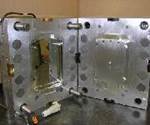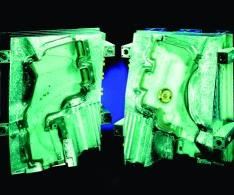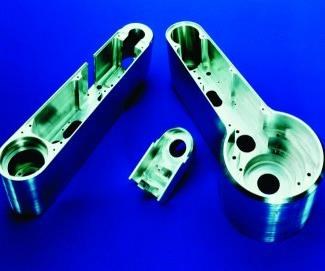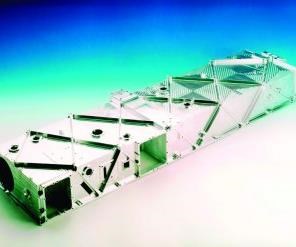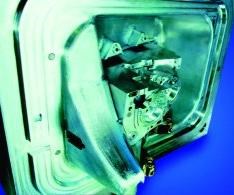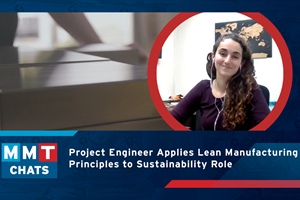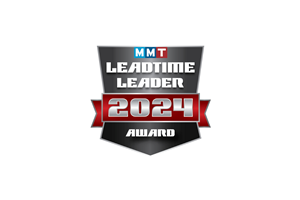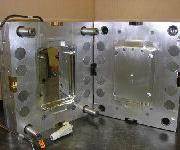Steel Wars: Aluminum Versus Steel
Conventional steel tools have some obvious advantages in the mold industry but aluminum proves to be gaining some strength in the competition.
With requirements for lowest weight, highest thermal conductivity and ease of machinability, tool and mold applications are a natural opportunity for aluminum. Aluminum producers have responded with often-proprietary and trade-named products tailored to meet the diversity of challenges presented by these applications.
Why Aluminum?
First, this question needs to be addressed. Alternative materials, particularly a range of steels such as P-20, H13 tool steel and stainless steels as well as copper-based alloys often containing beryllium, have been used in tool and mold applications. They offer high strength and wear resistance, and, in the case of the copper alloys, thermal conductivity. However, no material has all of the desired properties for a given application, and the alternative materials are no exception. They are heavy, often less machinable, and, with the exception of copper-based alloys, have poor thermal conductivity.
Overcoming those deficiencies is where aluminum comes into the picture. Compared to steel, aluminum:
- Has a four-fold increase in thermal conductivity. In molding operations, this reduces the required cooling cycles and also minimizes local hot spots that could lead to part distortion. Aluminum also allows for the design of simpler cooling systems, which require less design and machining time.
- Is lightweight. Aluminum has roughly one-third the density of steel. This makes handling of the tooling and molds easier, allowing faster opening and closing of molds and tools due to reduced inertia. In addition, lighter weight tooling results in less press wear and reducing maintenance and downtime. These benefits are particularly relevant to large tools and molds.
- Can be machined and polished more rapidly. Depending on the specific aluminum alloy, machining rates are three to ten times faster than that of steel. This reduces the time required for production, particularly for large molds with deep cavities.
- Exhibits high electrical conductivity. This, along with a lower melting point as compared to steel, enables the use of electrical discharge machining of aluminum at a rate four to five times higher than steel.
As a result of these benefits aluminum producers estimate that using aluminum over steel for mold applications can save 30 percent in mold manufacturing costs, which can increase to 40 percent if the reduced part production cycle times and improved productivity are included.
One area in which steel offers an advantage is in the area of surface hardness. In some applications, such as those involving conventional plastic molding, the base aluminum surface has adequate properties. However, for those cases where higher wear resistance is required, surface treatments of aluminum such as hard anodizing or nickel plating, result in aluminum surface hardness levels approaching those of steel.
Evolution
Since there is a range of different conditions under which tool and mold materials must operate, different aluminum alloy and temper combinations have evolved to meet the various needs. Both cast and wrought products are available in a wide range of thicknesses, widths and lengths. Each product type has specific characteristics that have been tailored to application needs.
Cast plate materials have the following advantages:
- Equiaxed grain structure-provided similar properties in all test directions;
- Low residual stress-created by a controlled, post-casting thermal annealing process;
- Extreme flatness tolerance capability-enabled by single-pass surface machining;
- Good internal soundness-produced by closely controlled casting process parameters and superior metal treatment;
- Excellent surface finish-achieved by specially designed milling heads with minimum metal removal.
Some of the applications in which cast plate materials have been used include food machinery molding plate and other low pressure molding, electrical heating plates, milling machine bedplate, automatic inspection machine board holder and screen printer base plate.
Wrought aluminum products also are widely applied. The nature of the improvements made to the plate products for use in tool and mold applications involved:
- Improved uniformity in thickness properties. This is especially important because the products are available in thicknesses up to thirty-five inches in some cases.
- Low residual stresses, accomplished through mechanical stress relief by stretching or cold compression after heat treatment.
- Excellent flatness.
For applications such as low-pressure plastic and composite molding, including thermoforming and resin transfer molding, that require a material with excellent corrosion resistance and weldability, 5xxx alloys are preferred. Similar to 5083-O are alloys such as Fibralr, Giantal, and Alumold 4-150 and 4-110.
Other applications such as low-pressure molding of rubber and other elastomers, which involve temperatures in the 350x to 400xF range, necessitate a moderate strength material with good property retention at moderately elevated temperatures. Here, aluminum producers offer alloys based on the 2xxx series, often similar to 2618 or 2219, which are traditionally the best conventional aluminum alloys from a high-temperature perspective. This group includes: Weldural, a 2219-type alloy, Tempralr, with the 2039 alloy composition, Alumold 3-350 and 3-300 and Alumec HT.
Another class of applications, particularly injection and compression molding as well as bolsters and force plates, call for high strength properties along with excellent machinability, high polishability and good shape stability. The 7xxx alloy family meets this need well, and products here include Certalr SPC, a 7122 alloy, Hokotol, a 7050-type composition, Alumold 1-600, 1-500, 2-450, and 2-400, and Alumec 79, 89, 99, and QC-7.
A survey of wrought tool and mold plate products would not be complete without mentioning moderate strength alloys of the 6xxx series. Specialized versions of 6061-T6 in stress relieved tempers are available both in plate as compression stress relieved thick 6061-T652 or 6061-T651 Type 200 plate as well as extruded form Acc-U-Plate and Econ-O-Plate. In addition, a higher-purity 6xxx for semiconductor applications in which anodizing is needed called Semi6 is offered. Also, 6013-PowerPlate is a rolled product with 25 percent higher strength than 6061-T6 and improved machinability rating of "B" versus the conventional "C" for 6061-T651.
The Future
While conventional aluminum tool and mold products have some obvious advantages in these application areas, the competition is not standing still. Some developing technologies include both aluminum and steel tools manufactured using rapid prototyping (RP) methods, which have been trialed in short production run applications successfully. Rapid manufacturing methods eliminate some of the advantages enjoyed by aluminum in terms of machinability and shorter leadtimes over conventionally processed steel. This area looks like one that will continue to see significant emphasis and development in the aluminum industry worldwide.
*Fibral, Tempral and Certal are registered trademarks of Alcan Aluminum Limited (Montreal, Canada).
This article appeared in the May/June issue of Aluminum Now, the in-house information journal of the Aluminum Association, Inc. The article was prepared courtesy of Secat, Inc. (Lexington, KY)-research resource for the aluminum industry.
Related Content
MMT Chats: Project Engineer Applies Lean Manufacturing Principles to Growing Sustainability Role
MoldMaking Technology Editorial Director Christina Fuges catches up with MMT’s 30-Under-30 Honoree Katherine Pistorius, who has added Regional Sustainability Coordinator alongside her Project Engineer duties, which demonstrates the many paths one can take in a manufacturing career. Here she shares how this opportunity unfolded for her and what the job entails today and in the future. This episode is brought to you by ISCAR with New Ideas for Machining Intelligently.
Read MoreFAQs: What Are the Leadtime Leader Awards?
Here are answers to some frequently asked questions about MoldMaking Technology's annual Leadtime Leader Awards competition.
Read MoreU.S. Economic Fundamentals Impacting Moldmaking
The economy continues to downshift, capping growth in moldmaking.
Read MoreCertified Quality Management for Plastics Professionals – Materials to Tooling to Recycling
Why is certification of a shop’s quality management system to ISO 9001, AS9100, IATF 16949 or ISO 13485 so special? What does the certification signify? And what supports the paper behind the framed certificate?
Read MoreRead Next
Optimizing Aluminum Tools
Plating aluminum molds for longer production life.
Read MoreAre You a Moldmaker Considering 3D Printing? Consider the 3D Printing Workshop at NPE2024
Presentations will cover 3D printing for mold tooling, material innovation, product development, bridge production and full-scale, high-volume additive manufacturing.
Read MoreHow to Use Continuing Education to Remain Competitive in Moldmaking
Continued training helps moldmakers make tooling decisions and properly use the latest cutting tool to efficiently machine high-quality molds.
Read More
